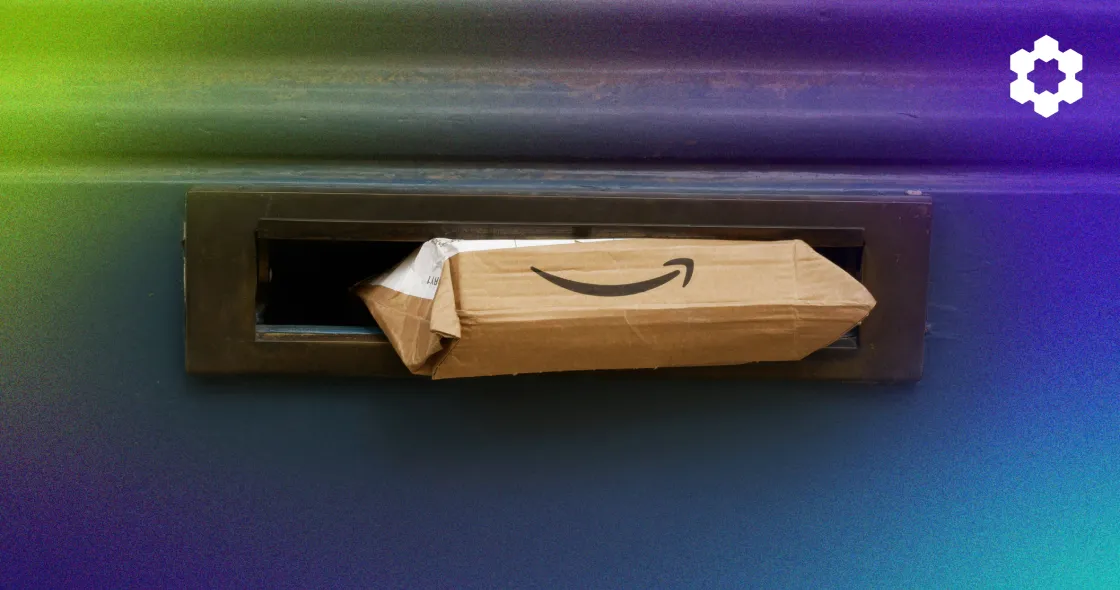This article is part of a 3-part series covering Amazon FBA fees and updates for 2024. For a comprehensive breakdown of fees and impacts, download the FREE whitepaper.
In Part 1 of our 2023 Amazon FBA fee update series, we learned about the major changes to fees for sellers in Amazon’s fulfillment program. These updates affect key areas like shipping fees, fulfillment fees, removal and disposal fees, and storage fees. While increased FBA fees present challenges, sellers can tweak their strategies to maintain strong margins.
In this post, we’ll take a deeper look at the impact of Amazon’s recent FBA fee adjustments on your business. Understanding how operating costs and price changes impact profit margins empowers you to stay competitive and make informed decisions. This comprehensive insight is essential for optimizing inventory, exploring fulfillment alternatives, and adjusting pricing models to ensure long-term business sustainability amid changing market conditions.
How Does Dimensional Weight Pricing Impact Shipping Cost?
Dimensional weight (DIM) pricing increases shipping costs by taking into account both the size and weight of a package when calculating shipping charges. Traditionally, shipping costs were determined based solely on the weight of the package.
However, with DIM weight pricing, if a package is relatively large compared to its weight, the shipping cost is calculated based on the package’s dimensions rather than just its weight.
This approach aims to address the shipping space that a package occupies in a carrier’s vehicle or storage, recognizing that larger packages may limit the number of items that can be transported, even if they are lightweight. As a result, larger and bulkier packages incur higher shipping costs under dimensional weight pricing, reflecting the resources required to handle and transport these larger items.
For sellers, especially those dealing with light but bulky items, the shift to DIM weight pricing means they may experience increased shipping costs compared to the traditional weight-based pricing model. To mitigate these costs, sellers often optimize packaging to reduce the size of their shipments and avoid higher dimensional fees.
How to Calculate DIM Weight?
Suppose you’re shipping within the US, here’s how much it would cost you to fulfill a small standard-size parcel across the country.
| Item unit weight | Item dimension (inches) | Item DIM weight | Greater of unit weight or DIM weight | Size and weight tier before DIM weight pricing took effect | Size and weight tier after DIM weight pricing took effect |
|---|---|---|---|---|---|
| 8 oz | 15″ x 12″ x 0.75″ | (15 x 12 x 0.75)/139 = 0.97 lb | DIM weight is 0.97 lb | Small standard | Small standard |
Tier: Small standard (non-apparel)
2023 Fulfillment Rate
Item unit weight rate (8 oz): $3.58
Item DIM weight rate (0.97 lb): $3.77
Item unit weight rate (8 oz): $3.58
Item DIM weight rate (0.97 lb): $3.82
DIM weight pricing may place you in a weight tier significantly higher than your actual unit weight implies, resulting in a substantial increase in per-unit fulfillment fees for your large but lightweight product.
Minimize parcel bulkiness by avoiding excess air in packaging or using an excessive amount of bubble wrap or foam fillers. Optimize shipping fees by adopting packaging strategies such as employing lightweight or condensed materials and eliminating unnecessary air or water from primary packaging.
You may also want to utilize our Master Carton Calculator to identify the optimal carton and pallet load capacity per shipment, securing additional savings to counterbalance Amazon’s DIM weight fees.
Rising FBA Fees Eroding Sellers’ Profit Margins

Amazon increased FBA fulfillment fees across categories in 2023, with some products seeing additional surcharges.
DIM Weight Pricing for Large Standard-Size Apparel
In 2022, Amazon introduced DIM weight pricing across its catalog, with the exception of apparel. However, as of February 16, 2023, apparel items falling within the large standard-size tier (4 oz to 20 lbs) will also be subject to DIM weight calculation. The shipping weight for apparel will now be determined by the greater of unit weight or DIM weight.
5% Fuel & Inflation Surcharge
In 2022, Amazon implemented a surcharge to address the temporary increase in price levels. Yet, as economic conditions evolved, these cost escalations have become more enduring. Consequently, the retail giant finds it necessary to permanently incorporate these additional costs into its 2023 FBA fees, making the current rates significantly higher with at least $0.22 average per unit increase for many US sellers.
Holiday Fulfillment Peak Surcharge
From October 15, 2023, to January 14, 2024, a holiday peak fulfillment fee will be applied to various orders, including US FBA, Canada FBA, Multi-Channel Fulfillment, and Remote Fulfillment with FBA. While the seasonal surcharge rates ($0.35/unit) for North America remain consistent with those in 2022, the holiday surcharge shows notable increases compared to off-peak fulfillment fees.
These increases include $0.20 more per unit for Small Standard, $0.30 more per unit for Large Standard (up to 2 lbs), $0.50 more per unit for Large Standard (between 2 lbs and 20 lbs), $1 more per unit for Small Oversize, and $2.50 more per unit for Medium, Large, and Special Oversize items.
2024 Low-Level Inventory Fee
Effective April 1, 2024, Amazon is set to implement the Low-Inventory-Level Fee specifically designed for standard-sized products.
The introduction of this fee serves as a proactive measure to motivate sellers to uphold optimal inventory levels, emphasizing the importance of efficient order fulfillment within the Amazon marketplace. In a blog post, Dharmesh Mehta, Vice President, Worldwide Selling Partner Services, said “sellers can avoid this fee by maintaining more than four weeks of inventory relative to sales.”
According to Amazon inventory management expert and SoStocked CEO, Chelsea Cohen, this new fee “is a fulfillment fee related to total days of supply at FBA. It is not a storage fee. This means that you will only be charged when you sell the stock. This fee kicks in upon fulfillment of the units being penalized.”
Failure to maintain more than four weeks of inventory in FBA can lead to a low level inventory surcharge ranging between $0.32 and $1.11 per unit.
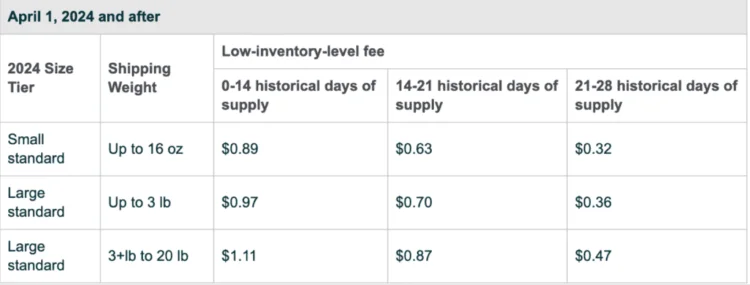
Mitigate the impact of this fee by prioritizing the accuracy of your demand forecasting, aiming to prevent instances of low inventory levels. Additionally, exploring temporary adjustments to advertising or pricing strategies can be beneficial in navigating potential spikes that might otherwise result in stock outs or trigger fees due to insufficient inventory.
New Product Size Tiers
The new fee structure also reveals new weight tiers, including 4 oz or less, 4+ to 8 oz, and 1.5 lbs, Large Bulky, and Extra Large. As such, shipping a 4 oz large standard-size apparel may now incur a cost of $4.43 per unit, Amazon’s previous rate for items weighing 6 oz or less in 2022. While this tier structure may benefit lighter products, it could lead to higher rates for some heavier products, affecting their cost under the new pricing system.
When DIM weight pricing is applied, your shipping fees could get even more expensive. Suppose your apparel only weighs 4 oz, but the DIM weight is 12 oz. In that case, you’re going to be charged $5.32 instead of $4.43/unit, a $0.89 difference.
Overall, fulfillment fees rose about 20% for standard items and 28% for large items compared to 2021. Amazon also adjusted size tiers to charge higher fees in new, more granular segments.
For example, the “Oversize” category now has “Large Bulky” and “Extra-Large” sub-tiers. While unavoidable, sellers can shift products into lower size/weight tiers to reduce fulfillment costs.
Removal & Disposal Orders Are Getting More Expensive
The fees Amazon charges for removing or disposing of inventory saw exponential increases in 2023, compounding the impact of dimensional weight pricing.
For example, a standard-size pillow would now cost $12.37 to remove, a 930% increase from 2021.
Worse, starting February 5, 2024, expect to pay 5% to 10% more per removal order.
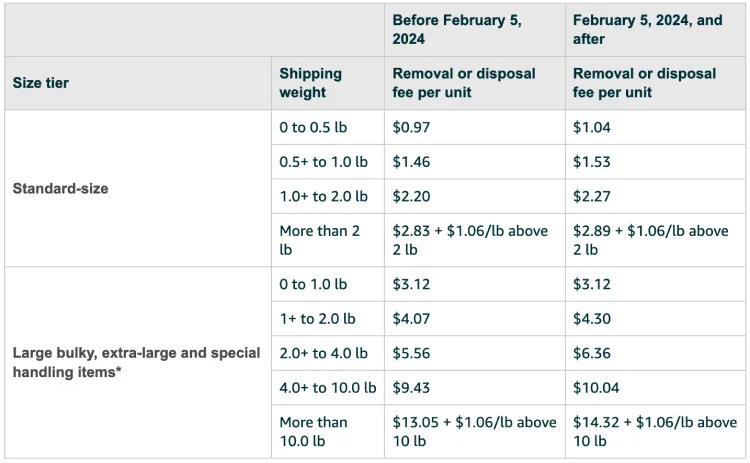
Careful forecasting and inventory management are vital to minimize costly removals and disposals. Strategic promotions or price reductions can help sell through stock before incurring these fees.
Amazon frequently commits various errors for which they compensate sellers. These errors include lost or damaged inventory and fulfillment mistakes during receiving, storing, shipping, or returning processes of your inventory. Despite Amazon implementing automated processes to identify some of these issues, sellers are advised to take a proactive approach to ensure they claim all eligible reimbursements.
For this reason, team up with an Amazon FBA reimbursement service provider who will thoroughly review your account for potential reimbursement opportunities. Providers such as chargeguard (1st party sellers) and Seller Investigators (for 3P sellers) are dedicated to expertly identifying and securing reimbursements on behalf of Amazon businesses, streamlining the process and ensuring maximum benefit for your business.
Making Sellers Pay for Keeping Excess Inventory at FBA
Sellers who don’t pay attention to their slow-moving products stand to pay more in Amazon storage fees, thanks to the new surcharges tied to excess inventory.
Aged Inventory Surcharge
On May 15, 2022, Amazon implemented an extra storage fee for inventory sitting in its warehouses for 271-365 days. Unlike the previous policy that enforced aged inventory fees after 365 days, also known as long-term storage fees, this change introduces an additional fee window within the 271-365 day range.
In 2023, Amazon introduced three new aged inventory tiers – 181 to 210 days, 211 to 240 days, and 241 to 300 days – as well as higher surcharges.
Sellers now face an unexpected and unwelcome increase in storage costs, as the aged inventory surcharge is poised to compound their financial burden with these new fees.
Aged inventory fees become applicable after the 6th month. For products aged between 181 and 210 days, an extra $0.50 per cubic foot will be charged in addition to other relevant storage fees. The surcharge may reach up to $6.90 per cubic foot for units aged 365 days or longer.
Sellers were also notified by Amazon that, unless they opted out, their settings would be automatically adjusted to “remove aging inventory” starting April 15, 2023. This update specifically pertains to inventory stuck in FBA for over 365 days, as well as items that haven’t sold in six or more consecutive months and have been stored in fulfillment centers for more than 180 days.
Monthly Capacity Limit-Related Fees
On March 1, 2023, Amazon has carried out changes to their restock limits system, introducing new inventory capacity restrictions and fees:
- Monthly Capacity Limit: Amazon has announced a new FBA capacity limit to replace quarterly IPI storage volume limits and restock limits. Now measured in cubic feet, sellers can bid for additional storage space of either 20% of the initial limit or 2,000 cubic feet, whichever is greater.
- Reservation Fee: This new fee is the maximum amount a seller is willing to pay or bid for the requested increase in storage space.
- Storage Overage Fee: Finally, the new storage overage fee penalizes sellers for exceeding capacity limits in Amazon’s warehouses, charged at a daily rate of $10 per cubic foot divided by the number of days in the current month.
This daily fee persists as long as excess inventory in FBA surpasses your monthly capacity limit. For instance, maintaining a 100 cubic foot of overage may result in a daily charge of $36 until the excess cubic footage is reduced.
Unfortunately, with limits measured in cubic feet instead of units, overages can easily occur. In addition to the fee, the ability to create new shipping plans will be restricted while the limit is exceeded.
Try to mitigate the impact of overage and reservation fees on your profits by prioritizing effective inventory management.
Accurate demand planning (to avoid over-ordering), limiting bids for additional storage to best sellers, placing excess stock on sale, and regular inventory level monitoring through the FBA Capacity Manager Dashboard can help you to avoid overages. Removals or liquidations of slow-moving inventory provide last resort options.
Storage Utilization Surcharge
Beginning June 1, 2024, Amazon is set to introduce new fee tiers for the storage utilization surcharge. Departing from the existing three-tier system (below 26 weeks, 26-39 weeks, and 39 weeks), sellers may now incur charges if their utilization ratio falls between 22 and 52+ weeks of total catalog-wide volume.
Off-peak period (January-September), April 1, 2024 and after
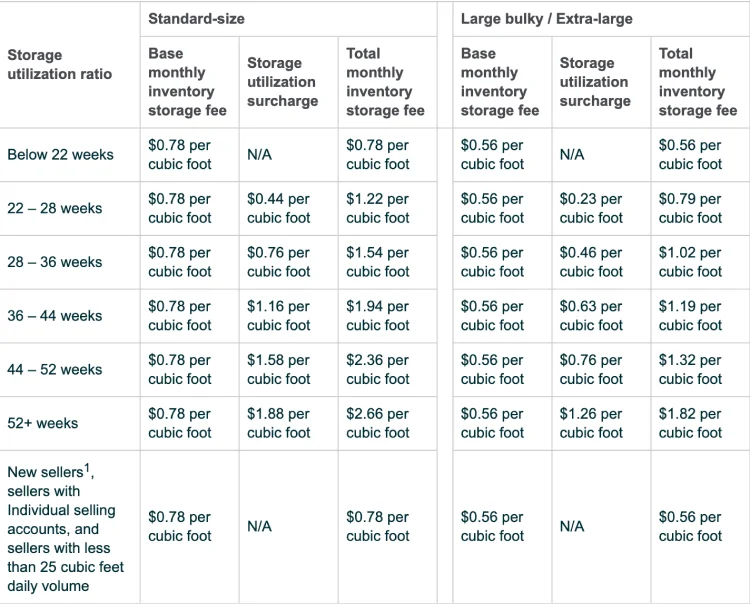
Peak period (October-December), Oct 1, 2024 and after
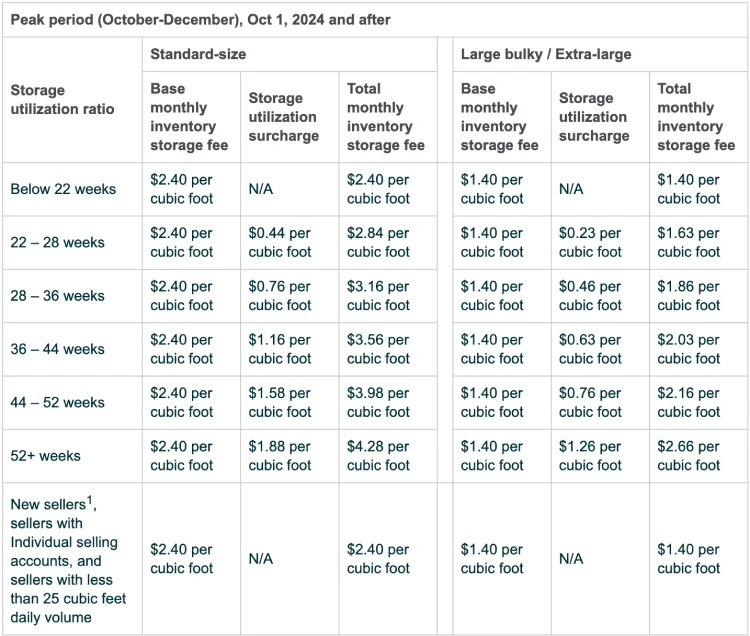
Meeting the criteria for this surcharge will result in its addition to the base monthly storage fee, causing an uptick in overall storage costs for sellers. Unlike a per-SKU basis, this surcharge is calculated based on the daily average volume, reflecting the total storage space occupied by your inventory in the FBA system.
Consequently, sellers with either very low volume or excessively slow-moving inventory may be the primary recipients of this additional fee.
Subjecting Sellers to Inbound Inventory Placement Fee
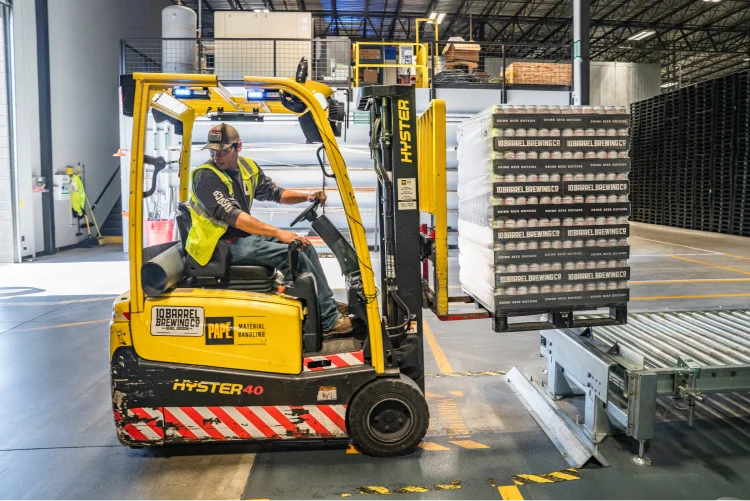
Starting March 1, 2024, an inbound inventory placement fee will be applied to standard and large bulky-sized items to cover the costs associated with transporting inventory from an initial receiving center to various fulfillment centers (FCs) across the US.
This strategic move by Amazon aims to bring inventory closer to cities, facilitating faster delivery speeds and reducing outbound transportation costs. While this shift benefits both Amazon and shoppers, it has the potential to significantly increase seller inbound fees.
However, in certain scenarios, the convenience of shipping to a single location instead of multiple ones may offset the fee through actual shipping cost savings.
Anticipate an expense ranging from $0.21 to $0.68 per unit for standard-size items and $2.16 to $6.00 for large bulky products when shipping to a single location.
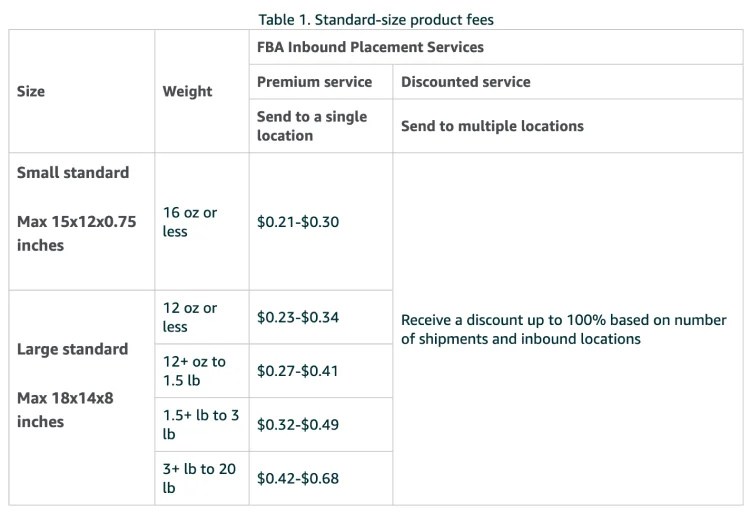

For sellers already saddled with massive profit erosion due to FBA fee increases in 2023, this fee adjustment could pose additional challenges.
Per Amazon, you could offset or avoid inbound shipping costs by opting for the program’s “Discounted” service.
Should your shipping plan meet the criteria (number of shipments, current inventory levels at FBA, and target inbound locations), you’ll be presented with the opportunity to opt for the “Discounted” FBA inbound placement service, allowing you to pay a reduced or zero fee when dispatching your inventory to various inbound locations within Amazon’s fulfillment network.
Take Proactive Steps to Stay Profitable
The array of Amazon FBA fee hikes in 2023 places further margin pressure on sellers. However, those taking proactive measures around packaging, inventory, pricing models, and promotions can greatly mitigate the impact.
Assessing potential 2024 fee changes also facilitates effective cost management, allowing sellers to make smart financial decisions and plan their budgets more accurately. This is crucial for maintaining a healthy profit margin and ensuring the overall financial well-being of the business.
Stay tuned for Part 3! We will uncover a set of strategies poised to aid you in restoring profitability and enhancing cash flow necessary for successfully growing your business amid skyrocketing FBA costs.





